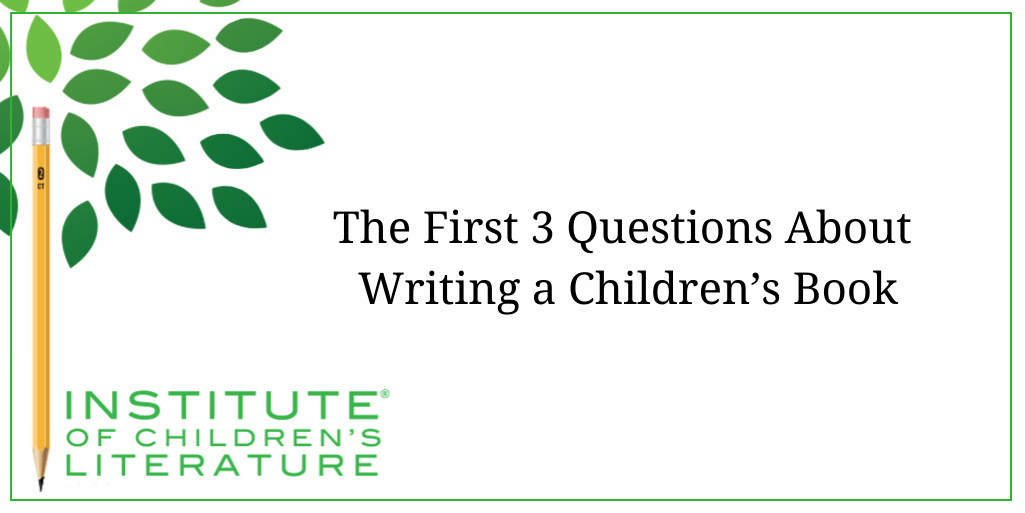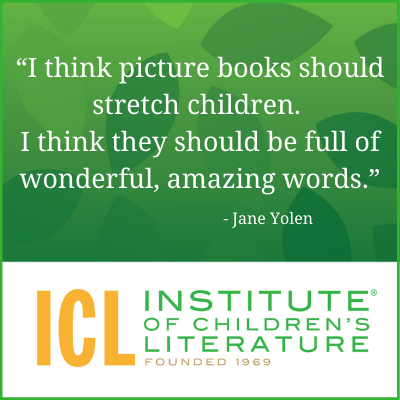
Your Voice or Theirs?
Voice, whether your natural writing voice or the voice of a character, comes from an emotional place. Jan Fields gives us exercises to develop these voices.

We teach our students how to write and get published!
View our Course Catalog >
Among all the many book formats, picture books and novelty books (board books, lift-the-flap books, and other books that require additional expense in manufacturing) tend to generate the most questions from new writers. Let’s look at the absolute most frequently asked three questions about writing a children’s book.
This is truly the most frequently asked children’s writing question of all time, anywhere, and the one that reflects the least amount of knowledge. Usually, people asking it have written a story they imagine will be published as a picture book, but by using the words “children’s book” (which covers a huge range of possibilities from board books to picture books to easy readers, chapter books, and even novels) they make answering difficult. With a question worded so broadly, there simply isn’t an answer to the question.

Now it’s possible you won’t find a book like yours. For example, maybe you want a lot of pictures but you’re targeting much older children and your story is quite long, but none of the examples you find have those qualities. Maybe you remember a book from your childhood or a very old classic work that meets the standard, but all the picture books you found when you went to the bookstore were short and targeted pre-readers. There are good reasons for that. Publishers have found that older, fluent reading children tend to shy away from picture books, considering them “babyish.” Parents also tend to view books similarly and will shop for chapter books or easy readers for school-aged children. The buyers are what have driven wordy picture book stories for older kids into only a very few publishers – and most of them are looking for either picture book nonfiction or things like historical fiction picture books or picture book memoirs. This is why it’s important to read picture books published within the last five years, so you can get a sense of the type of manuscripts publishers are currently accepting and publishing.
So, if you can’t find a book like yours, the answer to where to send it becomes far harder. Let’s look at what happens if you did find examples and you now know that you did, in fact, write a picture book for young children.
Once you know what sort of children’s book you’ve written, then you need a good market guide. If you plan to find a publisher for your book and for books you’ll write in the future, a market guide is worth buying. I, personally, consider them essential items in an author’s toolkit. And most have indexes in the back that can take you to publishers who publish the sort of book you’ve written. Among those publishers, you’ll find a few who accept submissions from writers and still more who accept submissions from agents. From there, you’ll either submit to one of the publishers who accepts submissions or begin the search for an agent open to picture book authors. Sure, that all sounds like work, but successful writers have pretty much all had to get used to the idea of doing lots and lots of work.
The short answer is “you don’t.” But that’s not completely fair. If you choose to self-publish or you choose to work with one of the really small publishers who only chooses projects that have illustrations attached (illustrations the author often pays for), then you will need an illustrator. But neither of these is the “usual” path for publishing a picture book. It’s not how the vast majority of picture books you’ve ever seen or read to your children were handled.
In most cases, authors have virtually nothing to do with choosing an illustrator. A number of different things go into a publisher’s choice of illustrator. For example, if the picture book isn’t some high concept book that publishers believe will find an instantly ready market (and most picture books aren’t), then publishers are interested in introducing something else to generate sales. An illustrator who is well known or who has won awards will draw book buyers (which include schools and libraries) so sometimes an unknown author with a really good picture book manuscript will be matched with a known illustrator to give the book the best chance at sales. If the publisher does not decide you need a “name” illustrator to generate sales, then they will find an illustrator who matches the style they see as matching the book’s vision. Publishers are familiar with the work of a great many illustrators and the strengths and weaknesses of the illustrators.
Authors don’t really have access to the same illustrators that publishers do because authors don’t have the finances of a successful publisher. Good illustrators aren’t cheap, and they shouldn’t be. Illustrating is a time-consuming occupation (often taking far longer than writing the text) and illustrators have often spent considerable money learning to be illustrators. There’s more to it than simply drawing cute pictures. Still, if you do go the route of hiring an illustrator because you want to self-publish, keep in mind that most book sales depend heavily on the quality of the illustrations. The story may catch the child’s interest and ensure the book is read over and over, but that initial sale is often a product of illustration more than text. The illustrations matter, so don’t choose an illustrator too quickly and be prepared to invest in a good one with real experience. There are illustrator groups as well as self-published author groups online so searching for “picture book illustrator” and looking at portfolios online can make you aware of the vast number out there, all with different styles, prices, and levels of experience. Choose wisely. A cheap illustrator (or a free one) is often a hindrance to having the quality book you imagine and a hindrance to sales.
Some new writers make their first sale of fiction either through educational publishers (writing things like fiction testing passages) or through magazine publishing (online or in print). That can be both exhilarating and edifying. An editor actually likes what you wrote! And readers do too! So, what’s next? This leads people to think maybe they should find a publisher who will make the story a picture book. Unfortunately, this rarely works (and even when it does, it only happens after extensive rewriting). The reason for this is that a short story is very different from a picture book. Sure, they are both tales told in few words, but the differences between the two outweigh the similarities.
Short story publication usually involves somewhere between 0 and 3 illustrations. Illustrations in short stories are intended to engage the reader in the story and draw the child who is only flipping through the magazine to stop and read. Illustrations in short stories don’t tell their own story. At best, they illuminate what is on the page. A short story must work with no illustrations at all. Because short stories must work really well without illustrations, they will almost always require the writer to do the job of the illustrator. In other words, the short story writer describes the visuals of the tale, helping the reader to see through words. In a picture book, the author doesn’t do this at all because the reader sees the visuals of the tale in the illustrations.
Also, short stories in magazines like Spider, for instance, are meant to be read by the child. So, the reading is a silent experience. Picture books aren’t meant to be read silently in a solitary experience. That means euphony is far more important in picture books. In a short story, the sound of the story is far less important, but accessibility is essential. Children don’t get to stop the reader of a Spider magazine story to ask what a word means, because the child is the reader. Short story writers must balance the demands of sensory writing, clarity, and euphony. Short stories aren’t built word for word in the same way as picture books.
Short stories and picture books are very different, so if you’ve ever wondered if your magazine short story should be sent to a book publisher, it is probably a signal that you need to read a few dozen picture books and think deeply about them. Maybe read them side by side with some children’s magazines and think about how the stories differ. The answer is going to become obvious as you study examples. And that study will help you to (1) zero in on the type of writing you really want to do and (2) help you to do it better. There is nothing wrong with being a short story writer and a great short story isn’t less valuable than a picture book. It’s simply an entirely different art form. And kids need both.
Are these all the questions new writers ask about picture books? Of course not. We’ll answer more questions and dig even deeper into picture books as the month progresses. If this is a writing area that interests you, consider spending the month reading as many picture books as possible. The more you read, the more your creative brain will produce stories that work. And that’s a winning strategy all around.
With over 100 books in publication, Jan Fields writes both chapter books for children and mystery novels for adults. She’s also known for a variety of experiences teaching writing, from one session SCBWI events to lengthier Highlights Foundation workshops to these blog posts for the Institute of Children’s Literature. As a former ICL instructor, Jan enjoys equipping writers for success in whatever way she can.

Voice, whether your natural writing voice or the voice of a character, comes from an emotional place. Jan Fields gives us exercises to develop these voices.

Voice is something publishers want, but it’s an elusive thing to understand. Today, we discover ways to develop our own voice and the voices of our characters.

When writing conflict, inner and outer conflicts are not two separate things. Outer conflicts offer an opportunity to explore inner ones better. Find out how.
1000 N. West Street #1200, Wilmington, DE 19801
© 2024 Direct Learning Systems, Inc. All rights reserved.
1000 N. West Street #1200, Wilmington, DE 19801
© 2024 Direct Learning Systems, Inc. All rights reserved.
1000 N. West Street #1200, Wilmington, DE 19801
© 2024 Direct Learning Systems, Inc. All rights reserved.
3 Comments